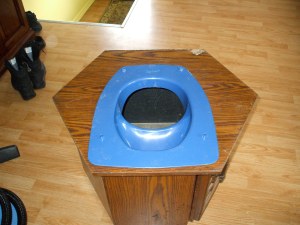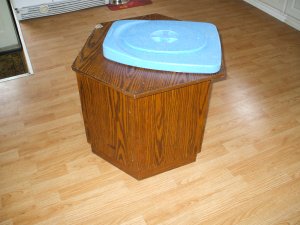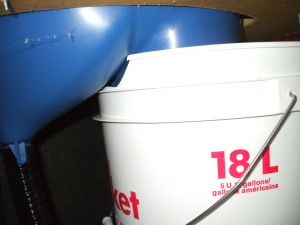As you all know, last year I did my business in the woods. This year I am building a small bathroom addition to Tiny House Ontario. Initially, when planning the build I had intended on putting this on the East side of the house. Then I changed my mind and decided to put it on the North, but I am back to wanting it on the East again because I already have a small exit in the tiny house (an old window) which will be removed and become a very small door, to a very small bathroom with a composting toilet and running (rain water) sink and shower.
The Sparett unit, Privy 500 came in. I am happy that it came in so quickly. I like the separation unit idea because I believe that urine creates a lot of STINK. I really do not want stink.
I was super easy to do! Took about a 45 minutes start to finish and that included finding the tools and getting photos. The template came on the box the unit are the three articles in the front, these cost $157.06 (including shipping). The 1970’s end table was $7 at a thrift shop, tax included and the bucket was $8. Total $172.06. I also required to use my jig saw to cut the hole.
I marked the template and cut the hole. Perfect fit! I also cut the surface overhang off the back so that I can put this against the wall to vent it out.
With that done, I put the four screws in place and attached the Privy 500 to the end table. I attached the urine hose to the Privy 500 and drilled an exit hole in the bottom of the cabinet because I will have this drain outside into a filtering bed. The hose is ridged only on the outside. I worried about this before it arrived because a smooth surface will make for a cleaner surface, right?
So far I am not sure what I think of the unit. I like the idea and keep in mind that I have not used this yet; but if I was designing it I would make a few changes already just looking at it. Sigh. The problems that I see are that the separation section in the middle does not come up very high. This is a problem for two reasons. First the urine can get into the collection bucket. But the bigger problem is that the bucket cannot go up to meet the plastic where the back drops down. I would also have dropped the back (interior) down farther too, so that it goes fully into the bucket.
See? There is a gap, if these two things were ironed out, then theoretically a person could put a top on the bucket, put a hole in there and the blue plastic privy 500 could be enclosed right inside the bucket. The bucket could then be lifted right up tight to the unit so that no air or dirt leakage is possible inside of my 1970’s reused end table. Further, a VENT could be then put into the bucket lid and let out behind the unit. There is LOTS of room for a vent and lots of room for improvement on this unit too.
The “insulated seat” that is included is nothing but a piece of styrofoam with a lid. Cheapo! The toilet seat version is not available in Canada but as the fellow told me on the phone it can be changed up to a regular toilet seat. I am not sure really what to do yet. I will know better after I use it a bit.
So here is what it looks like right now. I think I will add a toilet roll holder to one side and a container to hold my coconut fibre. Still not sure what colour to paint it. Possibly just plain old white.
No matter, it will be GREAT to not have to venture out to the woods in the dark!
___________
Just cut a little bit out of the bucket and put the bucket on the board that was cut out for the Privy 500. Made the fit a little tighter but did not resolve any of the issues above.









Where did you order the separator?
http://www.separett.ca/Torrdass-500-ca
We have several properties where we camp off grid. This year we bought two 5 gallon buckets from Home Depot, and a big bag of peat moss, for use at one of the properties. Urine is not deposited in the buckets, but it could be if we wanted to fill the buckets more quickly. Each gift to the bucket is covered with peat moss. The buckets are covered with a lid when not in use, and kept in a large weighted tote, with the lid held down by large rocks when we are absent from the camp. At the end of the camping season we emptied the buckets into a dedicated, to specification (see Humanuare Handbook), compost bin. No smell. No flies. It will take years to fill the compost bin, and when it is full we will leave it for five years (Ontario) before using the compost for ornamental gardening at the camp.
I have used outhouses all of my life. The humanure composting system is better by miles.
Humanure Handbook humanurehandbook.com
Hi Maggie,
This post is from a very long time ago. I changed systems and then changed again since then. I am still not really settled.
i would like to suggest that you change to coconut coir. This is just as absorbent… but 100% renewable.
Kind regards,
❤ L
The coconut coir is a good suggestion! We couldn’t find any reasonably priced. What we did find was a lumber mill where we could get sawdust (not from treated wood), which works well and has the added bonus that is it locally sourced.
Here we are four years down the road, how is it working thus far?
Hi Maggie the separator worked really well. The only thing that I am not a fan of is the seat and I could never figure out a better alternative.
This said, my installation was terrible. I made the space too large and mice were getting in. I had to close up the room so I removed it. I won’t be reinstalling it.
How nice to be able to discuss these fine points with people who are interested in the technology of the issue. Years ago I was trying to come up with a solution which did not involve an expensive septic tank and field and everyone I talked to about possibilities burst into laughter and made crude jokes which
I found very childish, and certainly not helpful. I settled on a Thetford porta-potty which served me well for more than thirty years in an unplumbed farmhouse, a pick-up truck and a van. I sold it for $25 when I had to buy a smaller model to fit into a camper van. I also tried two different commercial composting toilets, neither of which was completely successful, besides being very large. I recently
bought an old tin chemical toilet with a seat and lid and a pail inside. I am trying to figure out how to
make it urine-separating, and what to do with the urine. I like your idea of a filter. If urine is constantly
poured onto a compost pile I’m sure it will soon smell like a ghetto street. I love your resourcefulness
and practical approach to problems. Keep us posted!
Hey nice idea! Is this legal in Ontario? I would like to do the same thing if its allowed. Thanks
Essentially it is an outhouse with a couple of simple ecological switches. As far as I know these are legal in Ontario, but I am not a lawyer, so I can’t really give legal advice.
I googled and found this: http://cottagelife.com/14101/qa/ontario-regulations-for-outhouses
My ground water is 80 feet below the surface, I collect all my human waste and then put the collection into a hole when my bucket is filled. I change the location of the dump spot every year. So if the information on this website is correct, then I assume that my in-house is legal.
Truth is, when choosing such a lifestyle, one can work these problems out quite magically and never have to discuss them with anyone. Then the issue of your guests arise and finding a suitable solution for them becomes more if an issue. But truely, if you had a #1 pail and a #2 pail, it could really solve a lot of problems, and who says you need to do both at the same place? Separating urine from feces is much easier for men than women of course, otherwise one could install a urinal and a toilet. 🙂 http://www.permies.com is a wealth of info on this kind ot thing, and so much more.
Great project! I love how you’re figuring this out. However, the question remains…How many times did you sit on it to test it for comfort? ;^)